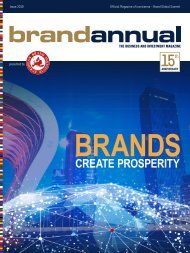iconannual2017
iconannual 2017 - The European Business and Investment Magazine "Brand together"
iconannual 2017 - The European Business and Investment Magazine
"Brand together"
You also want an ePaper? Increase the reach of your titles
YUMPU automatically turns print PDFs into web optimized ePapers that Google loves.
Austrian Institute of Technology<br />
At AIT, models are being<br />
developed on how urban<br />
centers of tomorrow can be<br />
simulated, planned and ultimately<br />
realized.<br />
Our services<br />
Developing tools in order to:<br />
• understand network interaction<br />
and support city planning<br />
• efficiently identify energy losses<br />
in the cities<br />
• visualize the effectiveness of<br />
CO 2<br />
reduction measures<br />
• reduce energy consumption in<br />
urban areas<br />
• increase the safety of the population<br />
and maintain water quality.<br />
Foto: Johannes Zinner/AIT<br />
Prof. Dr. Reinhard König,<br />
Senior Scientist at the Center<br />
for Energy, Sustainable<br />
Buildings and Cities, Austrian<br />
Institute of Technology<br />
„ Thanks to Design Space<br />
Exploration, we are<br />
developing models that<br />
provide an important<br />
basis to arrive at fast<br />
compromise solutions<br />
for complex urban<br />
planning issues.“<br />
Our work<br />
According to UN Habitat estimates,<br />
about 3 million people around the<br />
world are moving to urban centers<br />
every week – the proportion of the<br />
urban population will thus further<br />
increase in the coming decades<br />
and rise to about 70 percent by<br />
2050. This, however, also leads to<br />
increasing social and ecological<br />
challenges as cities are already<br />
one of the main causes of climate<br />
change. They consume about twothirds<br />
of the total energy and thus<br />
also account for a large part of CO 2<br />
emissions. Urban spaces are a very<br />
complex system in regards to their<br />
structure and networks, whose<br />
physical, social, technological and<br />
economic development depends on<br />
the interactions between the public<br />
sector, businesses, politicians<br />
and citizens of the city, but also on<br />
the interaction with the city surroundings<br />
and with other cities.<br />
Developing livable, resource-conserving<br />
and low-emission cities therefore<br />
requires special concepts,<br />
procedures, processes and tools to<br />
be deployed in a complex interplay<br />
with stakeholders.<br />
74 iconannual The European Business and Investment Magazine


